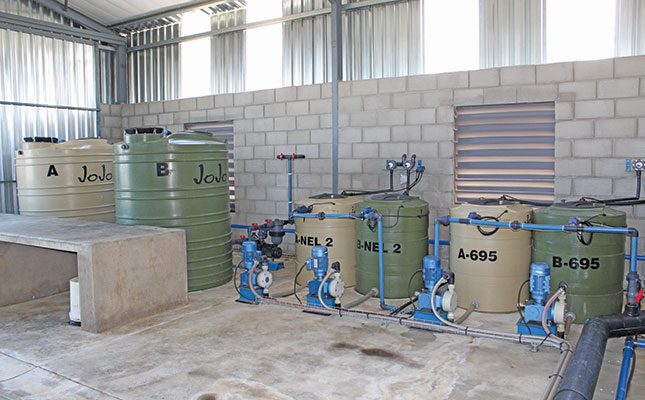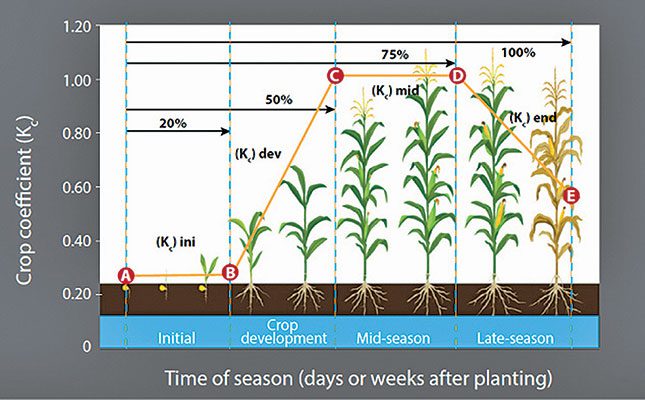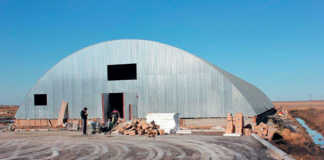
Photo: Lindi Botha
With all farming operations, the key objective is to improve yields and quality. This is achieved through nutrition, water, genetics and climate.
Focusing on water, a farmer’s chosen irrigation system can make or break his business.
READ Planning for precision irrigation
To get the best from an investment in irrigation, a farmer should ensure that the right system is implemented from the start, and then ensure that a proper maintenance programme is in place to keep this investment functioning optimally.
Get the numbers right
Hennie Needham, general manager of Rivulis Irrigation in South Africa, says that there are six key considerations farmers must keep in mind when choosing an irrigation system: the type of crop; the climate; the field shape and slope; the water source and quality; soil type; and energy source, availability and any limitations with power supply.
“Once all these factors are clear, it will be easier to determine the irrigation need, and therefore the size and individual components required to irrigate optimally.”

With the crop type in mind, the next step is to look at the climate, and in particular the water required to grow the crop in that specific climate. Needham explains that here, precipitation, evaporation, temperature, and wind need to be taken into account.
“With the knowledge of the specific crop you will grow, you need to determine its water requirement, which is measured by evapotranspiration. This in turn, is determined by solar radiation, temperature, humidity, and wind.”
The evapotranspiration (ET) is the total quantity of water that is used by the crop for transpiration, including evaporation from the plant itself and moisture lost through evaporation from the soil surface.
The rate of evapotranspiration is not static. It fluctuates daily, with trends across seasons. Solar radiation, temperature and wind speed increase ET, while humidity decreases it.
A rule of thumb for the late stages of crops is that the ET will generally be made up of 10% evaporation and 90% transpiration.
In general, a standardised measurement for evapotranspiration rate (ETo) is used, which is based on a reference crop of vegetative grass. The other half of the equation for plant water requirement is the crop coefficient (Kc).

This is a multiplier for a given crop used to predict water use at different growth stages. Kc data is based on numerous years of crop research, but it has to be adapted to the local variety and conditions.
There are numerous sources of Kc available – online, or at crop industry bodies, or seed companies.
To determine the crop’s water requirement, take the ETo and multiply it by Kc.
An example calculation will look as follows: ETo for the day is 4,4mm. It is mid-season, therefore the Kc is 1,15, and the sum looks as follows: 4,4 x 1,15 = 5,06mm. The water requirement is therefore 5,06mm.
This number should however be viewed with rainfall, and any precipitation must be taken into account to establish the total water availability, and how much irrigation is required in a season.
Once this data is established, it must be multiplied by the farm size to determine the total water and irrigation requirement.
For the hydraulic design, however, the figure that is most important is the largest irrigation volume amount in the season, as this is the volume of water that the system needs to be able to apply.
Determining water requirement
Needham notes that a common mistake is using average water requirement as a guide for an irrigation system.
READ Smart irrigation saves water
“If you do this during peak water demand periods, there is a deficit of water, which leads to yield reduction, often at the most critical time. The final irrigation design needs to be based on the peak water requirement, not the average water requirement.”
The lay of the land
Each farm is unique in its layout, and field and block configuration.
An irrigation system must therefore be designed with a specific farm in mind, and one design can’t necessarily be copied and pasted for another.
A topographical study of the farm will assist in determining piping and distribution, distances from water source and pump shed, and pressure requirement.
The slope of the farm impacts the type of irrigation, since water pressure increases as elevations decrease across the field.
Fixed items like field and service roads must taken into account.
The next item on the planning checklist is soil type. Sandy soils that leach easily require more frequent intervals, while clay soils need less frequent intervals.

Soil type will also determine whether you need to apply water slowly to ensure soil infiltration and minimise run-off. Dripper spacing is determined by how the water will move laterally through the soil due to the soil type.
Once you are armed with all this information, you can approach an irrigation company to provide you with the best solution for your farm, ensuring optimal yields and quality.
Fertigation considerations
Plant nutrition is one of the key areas where a massive impact can be made to increase success in crop production.
Plants need nutrients to grow, fight off diseases and pests and reproduce, and the better equipped they are, the greater the yields.
Adding a fertiliser component to irrigation is one of the best ways to ensure that plants get exactly what they need, when they need it.
Charl van Reenen, agronomy manager at Netafim South Africa, explains that precision fertigation is an optimal root-zone management tool delivering just the right combination of water and nutrients directly to the roots of each plant according to crop phenological cycles.

“Successful plant nutrition is all about exact quantities, correct nutrient combinations and precise timing. By applying nutrition through the irrigation system and using precision dosing technology to do so, you can ensure that the correct quantity and combination of nutrients is applied exactly when the crop needs it.”
Planning and executing a fertigation plan and fertigation system requires additional research and consultation.
Important information during the planning process includes fertiliser practices, average yield, climatic and environmental conditions, typical nutrition-related challenges faced, and the necessary water and soil analysis information.
The three most important building blocks of a fertiliser plan are the nutrient needs of the crop required to achieve the production goals, the required fertilisers and quantities to achieve the nutrient recommendations, and the application method.
It is clear that this aspect, too, requires a tailor-made plan, and can’t be copied from another farm.
Van Reenen says the initial cost of implementing fertigation may be high, but the reward outweighs the cost over and over.
READ Irrigation technology is making production cheaper
“Rewards include savings in fertiliser, labour and energy costs. Secondly, the increase in yield, as a result of optimised fertilisation, is often substantial.”
These rewards are, of course, only yielded if fertigation is done right. Monitoring during the season and adjusting the fertigation actions in real time is the final key to increased success.
Keep the system running
An irrigation system, like a tractor, requires regular servicing and maintenance to ensure it is running in tip-top condition.
Since irrigation water is unlikely to be perfectly clear and without any soil particles, a filter maintenance programme is essential to keep the system running and prevent massive blockages.
Such a maintenance plan results in lower overall maintenance cost, reduced equipment replacement costs, fewer interruptions to critical operations, improved equipment longevity, and increased efficiency.

Dexter Neethling, product manager for Netafim South Africa, relates that his team often notices on farms that filter maintenance is neglected, or done incorrectly, which leads to yield losses.
He advises farmers to divide maintenance into three sections: weekly maintenance, also maintenance at the end of the irrigation season, and that which is done at the start of the irrigation season.
“Visual inspection and testing of components is an integral part of preventative maintenance, be it inspecting filter rings or checking the pressure differential between the filter inlet and outlet. This ensures that possible problems are identified and corrected before they have a significant impact on the efficiency and longevity of the entire irrigation system,” says Neethling.
Irrigation maintenance steps
For screen filter maintenance, weekly visual inspections need to be conducted on automatic, semi-automatic and manual screen filters.
The focus should be on checking for leaks, which should be repaired as soon as possible.
If there are no leaks on the automatic screen filter, activate a manual flushing cycle to ensure the filter is flushing successfully.
The next step is to check the pressure differential. If this value is abnormally high, perform two more manual flushing cycles.
If the value remains high after three manual flushing cycles, the filter should be opened, checked for failed parts and the screen cleaned manually if necessary.
Follow the manufacturers guide
Be sure to follow the manufacturer’s step-by-step guide and all safety instructions when opening the filter and taking out the screen.
To clean the removed screen, use pressurised water to remove the remaining dirt. Reinstall the clean screen according to the supplier guidelines and follow all safety instructions.
READ Is subsurface irrigation about to take off in South Africa?
In a semi-automatic screen filter, the cleaning operation must be initiated before the pressure differential reaches 0,5bar.
Some semi-automatic screen filters have an automatic clogging indicator that will communicate when the pressure differential limit is reached.
To initiate the cleaning operation, open the drain valve and turn the handle all the way out and then back in. The screen’s interior will be cleaned as you turn the handle and suction is created in the nozzles.
If you are working with poor water quality or low pressure, it is advisable to perform the cleaning operation while the downstream valve is closed. Close the drain valve after the process has been completed.

If the pressure differential remains abnormally high after three completed cleaning operations, the filter should be opened, checked for failed parts and the screen cleaned manually if necessary.
In a manual screen filter, a high-pressure differential will always require opening the filter for manual cleaning. Start by closing the water supply to the filter and opening the drain valve to release all the pressure.
Open the filter body clamp and remove the filter cover. Carefully pull out the screen element and clean it using pressurised water.
If necessary, use a soft nylon brush for more efficient cleaning. Never use any abrasive tools and make sure the body and screen O-rings are lubricated before reassembly.
Disc filters also require regular maintenance and should undergo a general inspection regularly. This should be done before any scheduled maintenance procedures are carried out.
Check the pressure differential between the filter inlet and outlet, then initiate a flushing cycle and recheck the pressure differential a minute after the flushing cycle has been completed.
If the pressure differential is still abnormally high, you will need to open the filter and remove the discs for manual cleaning. Before removing the filter cover, close the water supply to the filter and open the drain valve to release all the pressure.
Visually inspect the discs after they have been removed. If there is visible sediment, clean the discs according to the supplier’s recommendations.
Furthermore, visually inspect the spine and make sure the cone membrane is not damaged. If any filter parts are damaged, replace them immediately.
When reassembling the spine and discs, make sure the number of discs is correct as indicated by the line on the spine, and lubricate the O-rings. Also, open the command filter and clean its discs.
Neethling states that various factors determine the success of an irrigation system, of which filter selection and set-up is but one aspect.
“To ensure that a filtration system keeps functioning effectively and has a long lifetime, two factors should never be neglected: the use of quality products, and system maintenance.
The message is clear: you cannot afford to risk the financial viability of your project by not investing in the best possible irrigation equipment.
“With regard to maintenance, be sure to take the right actions at the right time to ensure efficiency is maintained and filters perform at their full potential,” says Neethling.
Email Charl van Reenen and Dexter Neethling at [email protected], or Matt Needham at [email protected].











